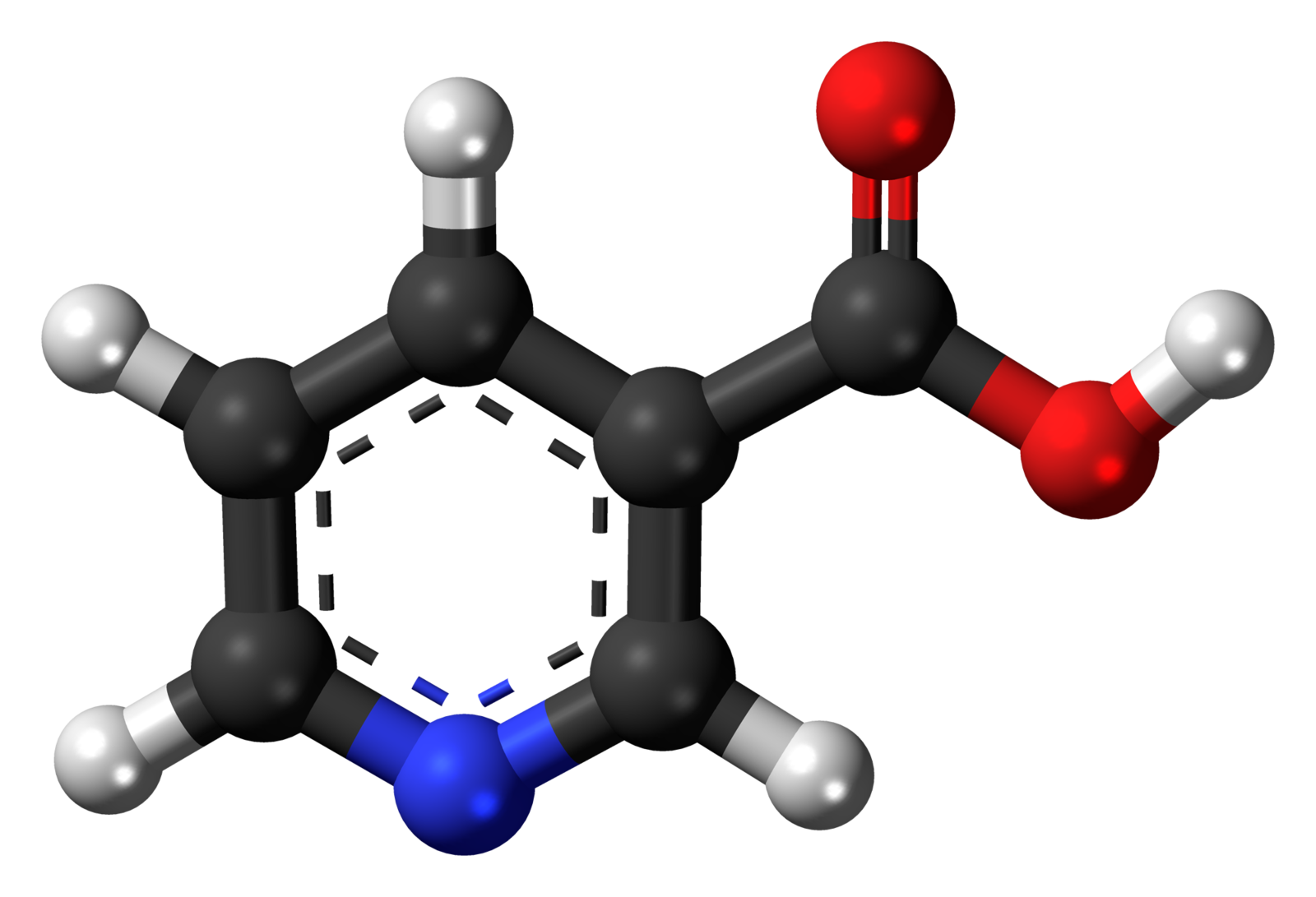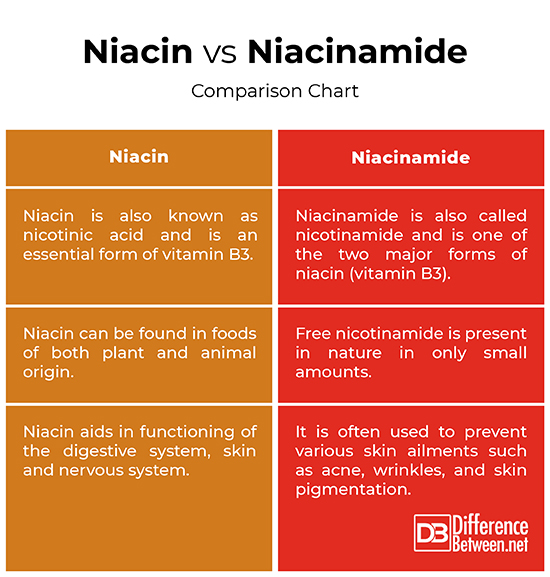Difference Between Niacin and Niacinamide
Vitamins are essential micronutrients that the human body needs to grow, develop normally and maintain its functions. Vitamins are generally categorized into two forms: fat soluble vitamins and water soluble vitamins. The water soluble vitamins are the vitamin B-complex group of vitamins that are transported to different body parts to aid in the functioning of the human body. Niacin and niacinamide are the two forms of vitamin B3.

What is Niacin?
Also known as nicotinic acid or vitamin B3, niacin is one of the eight B-complex water-soluble vitamins used by the human body to turn food into energy. Niacin is a vitamin essential to energy metabolism. Vitamins are organic micronutrients that are essential for the growth and development of the human body. Niacin is B-group vitamin that plays a major role in numerous metabolic reactions in the body. It helps in functioning of the digestive system, skin and nervous system. Niacin is a very important drug in treating cholesterol problems, particularly people with elevated triglycerides and low HDL. In fact, it’s one of the best drugs out there that can raise your HDL levels. It comes in many forms and each form has various uses as well. Niacin is found in food sources such as fish, meat, eggs, milk, yeast, nuts, green vegetables, beans, and cereal grains.

What is Niacinamide?
Niacinamide, also called nicotinamide, is one of the two major forms of niacin (vitamin B3) used to prevent vitamin B3 deficiency and related conditions such as pellagra – a disease which includes dermatitis and red lesions. In the first half of the 20th century, thousands of deaths in the United States have been attributed to pellagra until simple dietary supplements with vitamin B3 was found to cure the disorder. Today, niacinamide is one of the most hyped ingredients in the skin care market; in fact, it’s found in many skin care products. Niacinamide is a precursor to two very important biochemical co-factors: NAD and NADP. These two molecules are involved in several biochemical reactions that your cells, including skin cells, need to repair skin damage and provide appearance benefits to aging skin.
Difference between Niacin and Niacinamide
Vitamin Form
– Niacin and niacinamide are the two vitamins of the vitamin B-complex group of vitamins that are responsible for numerous metabolic reactions in the body. Niacin, also known as nicotinic acid, is a form of vitamin B3 – an essential nutrient that aids in growth and development of the human body. Niacinamide, also called nicotinamide, is one of the two major forms of niacin that plays an essential role in energy metabolism and cell health.
Nature/Food Sources
– Niacin can be found in foods of both plant and animal origin. Large quantities of niacin are found in fish, meat, eggs, milk, yeast, nuts, green vegetables, beans, and cereal grains. Niacin is present in uncooked foods mainly as the pyridine nucleotides NAD and NADP. Niacinamide is also found in many vitamins B complex supplements and in the same food sources as niacin. However, free nicotinamide is present in nature in only small amounts.
Medicinal Benefits
– Niacin is one of the simplest vitamins that aids in functioning of the digestive system, skin and nervous system. It is a very important drug in treating cholesterol problems, particularly people with elevated triglycerides and low HDL. Niacinamide is one of the major forms of niacin found in supplements and is often used to prevent various skin ailments such as acne, wrinkles, and skin pigmentation. It contains two active ingredients that are beneficial to improving skin’s appearance and promoting healthy skin.
Niacin vs. Niacinamide: Comparison Chart

Summary
Niacin is one of the simplest forms of vitamin B3. The two forms of niacin are nicotinic acid and nicotinamide, both of which serve as excellent sources of vitamin B3. Niacin is the generic term for pyridine-3 carboxylic acid and nicotinic acid amide. Niacinamide is one of the forms of niacin which contain two coenzymes – NAD and NADP – two molecules responsible for several biochemical reactions in the human body. Physically speaking, both are organic compounds that are colorless, odorless, and are soluble in water and alcohol.
Is niacinamide safer than niacin?
Niacin in high doses can cause your blood vessels to widen, a condition called flushing. Niacinamide does not cause skin flushing, thus, it is preferred over niacin for the treatment of pellagra – a vitamin B3 deficiency disorder.
What is the difference between niacin and B3?
Vitamin B3 is an essential nutrient that the human body needs to function properly. It is one of the eight B-complex water-soluble vitamins used by the human body to turn food into energy, and niacin is a form of vitamin B3.
How do you convert niacin to niacinamide?
The human body has the ability to convert niacin to niacinamide. Niacin is water soluble so if you take it in excess amount that your body does not need, it is converted to niacinamide. Niacin is converted to niacinamide by intestinal bacteria.
Who should use niacinamide?
The ingredients in niacinamide help calm the symptoms of mild acne, oily skin, skin pigmentation, inflamed skin, and other skin related problems. This is beneficial for all skin types.
Can I use niacinamide every day?
Niacinamide supplements should only be taken if prescribed by your doctor or healthcare provider for treating a vitamin B3 deficiency and any other skin disorder. In high doses, it can cause serious side effects such as skin irritation, burning, itchiness, or redness.
Is 10% niacinamide too much?
The concentration of topical niacinamide skin care products go up to 10%, but according to studies, they are as effective with as low as 2%.
- Difference Between Caucus and Primary - June 18, 2024
- Difference Between PPO and POS - May 30, 2024
- Difference Between RFID and NFC - May 28, 2024
Search DifferenceBetween.net :
Leave a Response
References :
[0]LeBlanc, Jean Gu and Graciela Savoy De Giori. B Group Vitamins: Current Uses and Perspectives. London, United Kingdom: InTech Open, 2018. Print
[1]Preedy Victor R. B Vitamins and Folate: Chemistry, Analysis, Function and Effects. London, United Kingdom: Royal Society of Chemistry, 2013. Print
[2]Farris, Patricia K. Cosmeceuticals and Cosmetic Practice. New Jersey, United States: John Wiley & Sons, 2013. Print
[3]Vandamme, Erick J. and José Luis Revuelta. Industrial Biotechnology of Vitamins, Biopigments, and Antioxidants. New Jersey, United States: John Wiley & Sons, 2013. Print
[4]Image credit: https://commons.wikimedia.org/wiki/File:Niacinamide.png
[5]Image credit: https://commons.wikimedia.org/wiki/File:Niacin-3D-balls.png
